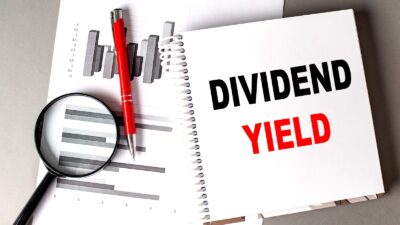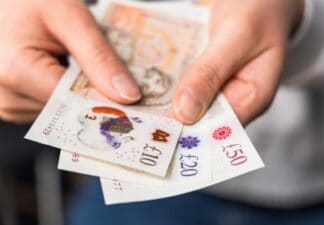UK stocks took a hit last week following the news about reciprocal tariffs from the US on countries around the world. Some companies are more impacted than others, but the weak sentiment from investors saw most shares fall. This is bad news for some, but it’s a source of positive news for those trying to make passive income.
Prices down, yields up
To understand why falling share prices can be good for income investors, let’s go back to understanding what these investors look for. Most focus on the dividend yield calculation. This provides (as a percentage) the yield based on the dividends paid over the last year, factoring in the current share price. Usually, the higher the yield, the more attractive it is.
Given the fall in the share price for many stocks and the fact that the dividend per share doesn’t update that often, the dividend yield for some shares has increased in recent days. So, if an investor bought a stock today versus last week, their yield will likely be higher. That’s why I refer to this correction as good news.
Should you invest £1,000 in Halma Plc right now?
When investing expert Mark Rogers has a stock tip, it can pay to listen. After all, the flagship Motley Fool Share Advisor newsletter he has run for nearly a decade has provided thousands of paying members with top stock recommendations from the UK and US markets. And right now, Mark thinks there are 6 standout stocks that investors should consider buying. Want to see if Halma Plc made the list?
However, there’s an important caveat. For companies likely to struggle due to the tariffs, there’s the potential for the future dividend to be cut if finances suffer. So the yield in the long run could fall. Rather, investors should be targeting stocks that aren’t impacted by the announcement. The stocks could have been caught up in the broader selling for no good reason.
A lack of major impact
For example, consider Aviva (LSE:AV). The insurance and pension provider’s share price dropped 6% last week. Over the last year, the stock is up 6%. With the recent fall, the dividend yield has increased to 6.8%.
Aviva sold its US business back in 2013 and since then hasn’t had any major operations across the. So there shouldn’t be any issues with cross-border trade here going forward. It’s true that some of the pension funds that it runs that have exposure to stocks will have underperformed. This is one reason why the stock dropped. Some investors might look to pull their money out from being managed by the company.
Yet in reality, the 6% drop lacks any real meaning to me. I believe this is just a fall based on general investor fear, rather than it being based on anything fundamental for Aviva. If anything, insurance operations shouldn’t be impacted at all, with revenue and profits remaining on track. Therefore, the dividend shouldn’t be under threat, and it could be an attractive option for income investors to consider now.
One risk is that the company is exposed to large payouts should a natural disaster, extreme weather or something else occur that impacts the insurance claims. Yet overall, I think it’s a business that’s well run with good potential.








